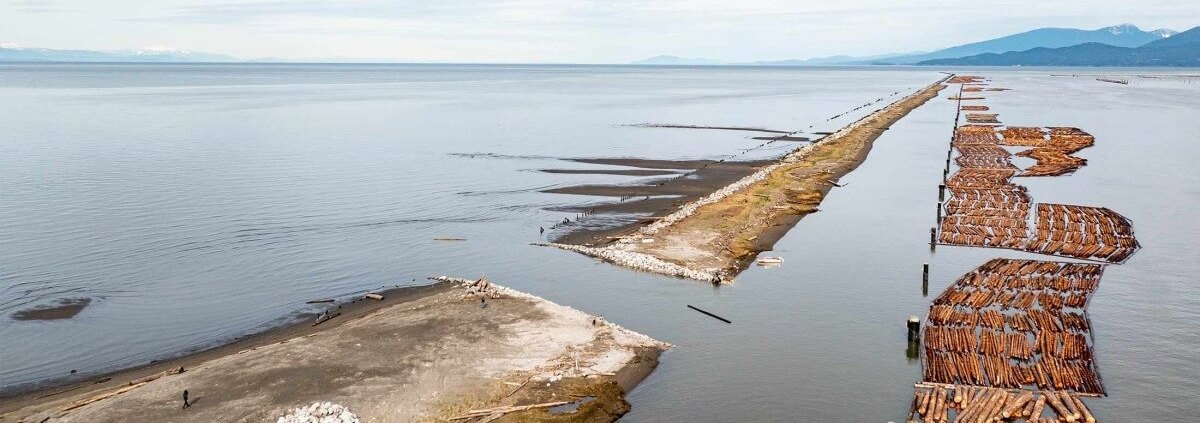Fraser Chinook salmon can now reach estuary habitat that was inaccessible for 100 years
Habitat restoration project sees immediate success after creating an opening in a 7km structure that has blocked salmon habitat for over a century.
Released on April 12, 2022
Photo by Alex Harris / Raincoast Conservation Foundation.
VANCOUVER, BC: For the first time in over a century, juvenile salmon now have access to habitats they rely on to feed and grow as they transition from the Fraser River to salt waters of Georgia Strait. A salmon restoration project has created a “breach” in a century-old structure that now provides an access route for young salmon to reach their preferred habitat. The project is led by the Raincoast Conservation Foundation and its partners, including the Pacific Salmon Foundation (PSF), Ducks Unlimited, Tsawwassen First Nation and Lower Fraser Fisheries Alliance.
The North Arm Jetty, a 7-kilometre-long barrier, has been forcing young salmon from the freshwater of the Fraser River’s North Arm into the deeper waters of the Strait of Georgia. Juvenile salmon rely on the brackish marsh habitats that lie in between the river and the Strait of Georgia to rear and feed before they transition to the ocean.
Following the breach made in early March, Raincoast has been monitoring the 30-metre wide opening and is already observing juvenile salmon passing through the breach. This immediate success makes this habitat restoration project rare.
Harrison River Chinook used to be the most productive Chinook salmon population in the Fraser, but has been declining for more than a decade and is now considered threatened by the Committee on the Status of Endangered Wildlife in Canada (COSEWIC). Juvenile Chinook, likely from the Harrison River, have been captured using the breach passage already. Chinook are the main target species of our restoration efforts as they rely on estuary habitats for a crucial growth period before continuing their migration to sea.
“Juvenile salmon rely on access to estuary habitats to adapt to salty waters and for important feeding opportunities that can improve their ability to survive in the ocean,” says Dave Scott, a biologist with Raincoast Conservation Foundation and a PhD-candidate in the Pacific Salmon Ecology and Conservation Lab at UBC.
“Given our understanding of how vital the Fraser estuary is for juvenile Chinook salmon, it is only right that we start to fix some of the damage humans have caused. Projects like this are addressing some of the problems we created. This will hopefully give these fish a fighting chance on their way into the open ocean,” says Scott, Raincoast’s Fraser Estuary Research and Restoration Coordinator.
The Lower Fraser River and estuary is a highly modified environment with more than 80% of tidal marsh habitats that juvenile salmon rely on either lost or inaccessible. On the Fraser delta, this includes the jetties, causeways and training walls that were built to control the arms of the river for ship navigation.
This restoration follows on Raincoast’s success in creating three breaches in the Fraser River’s South Arm on the Steveston Jetty in 2019. Raincoast biologists found high numbers of juvenile salmon passing through to reach the marsh on Sturgeon Bank, instead of being swept out to Georgia Strait. Raincoast plans on creating two more 30-metre-wide breaches in the North Arm Jetty to continue to restore natural migration pathways for juvenile salmon, other fish species and natural flow of freshwater and fine sediments.
This project was made possible by funding from the Pacific Salmon Foundation, the Province of BC and the Government of Canada.



